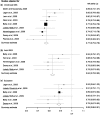Intelligence in youth and all-cause-mortality: systematic review with meta-analysis
- PMID: 21037248
- PMCID: PMC3147066
- DOI: 10.1093/ije/dyq190
Intelligence in youth and all-cause-mortality: systematic review with meta-analysis
Abstract
Background: A number of prospective cohort studies have examined the association between intelligence in childhood or youth and life expectancy in adulthood; however, the effect size of this association is yet to be quantified and previous reviews require updating.
Methods: The systematic review included an electronic search of EMBASE, MEDLINE and PSYCHINFO databases. This yielded 16 unrelated studies that met inclusion criteria, comprising 22,453 deaths among 1,107,022 participants. Heterogeneity was assessed, and fixed effects models were applied to the aggregate data. Publication bias was evaluated, and sensitivity analyses were conducted.
Results: A 1-standard deviation (SD) advantage in cognitive test scores was associated with a 24% (95% confidence interval 23-25) lower risk of death, during a 17- to 69-year follow-up. There was little evidence of publication bias (Egger's intercept = 0.10, P = 0.81), and the intelligence-mortality association was similar for men and women. Adjustment for childhood socio-economic status (SES) in the nine studies containing these data had almost no impact on this relationship, suggesting that this is not a confounder of the intelligence-mortality association. Controlling for adult SES in five studies and for education in six studies attenuated the intelligence-mortality hazard ratios by 34 and 54%, respectively.
Conclusions: Future investigations should address the extent to which attenuation of the intelligence-mortality link by adult SES indicators is due to mediation, over-adjustment and/or confounding. The explanation(s) for association between higher early-life intelligence and lower risk of adult mortality require further elucidation.
Figures





Comment in
-
Commentary: Intelligence in youth and all-cause mortality: some problems in a recent meta-analysis.Int J Epidemiol. 2011 Jun;40(3):644-6. doi: 10.1093/ije/dyr079. Epub 2011 May 6. Int J Epidemiol. 2011. PMID: 21551224 No abstract available.
Similar articles
-
Systemic pharmacological treatments for chronic plaque psoriasis: a network meta-analysis.Cochrane Database Syst Rev. 2021 Apr 19;4(4):CD011535. doi: 10.1002/14651858.CD011535.pub4. Cochrane Database Syst Rev. 2021. Update in: Cochrane Database Syst Rev. 2022 May 23;5:CD011535. doi: 10.1002/14651858.CD011535.pub5. PMID: 33871055 Free PMC article. Updated.
-
Home treatment for mental health problems: a systematic review.Health Technol Assess. 2001;5(15):1-139. doi: 10.3310/hta5150. Health Technol Assess. 2001. PMID: 11532236
-
Intracavity lavage and wound irrigation for prevention of surgical site infection.Cochrane Database Syst Rev. 2017 Oct 30;10(10):CD012234. doi: 10.1002/14651858.CD012234.pub2. Cochrane Database Syst Rev. 2017. PMID: 29083473 Free PMC article.
-
Signs and symptoms to determine if a patient presenting in primary care or hospital outpatient settings has COVID-19.Cochrane Database Syst Rev. 2022 May 20;5(5):CD013665. doi: 10.1002/14651858.CD013665.pub3. Cochrane Database Syst Rev. 2022. PMID: 35593186 Free PMC article.
-
Nutritional interventions for survivors of childhood cancer.Cochrane Database Syst Rev. 2016 Aug 22;2016(8):CD009678. doi: 10.1002/14651858.CD009678.pub2. Cochrane Database Syst Rev. 2016. PMID: 27545902 Free PMC article.
Cited by
-
Are Psycho-Behavioral Factors Accounting for Longevity?Front Psychol. 2019 Nov 14;10:2516. doi: 10.3389/fpsyg.2019.02516. eCollection 2019. Front Psychol. 2019. PMID: 31798494 Free PMC article.
-
Individual Differences in Attention and Intelligence: A United Cognitive/Psychometric Approach.J Intell. 2021 Jul 2;9(3):34. doi: 10.3390/jintelligence9030034. J Intell. 2021. PMID: 34287328 Free PMC article.
-
Gains in Life Expectancy Associated with Higher Education in Men.PLoS One. 2015 Oct 23;10(10):e0141200. doi: 10.1371/journal.pone.0141200. eCollection 2015. PLoS One. 2015. PMID: 26496647 Free PMC article.
-
Maternal Plasma 25-Hydroxyvitamin D during Gestation Is Positively Associated with Neurocognitive Development in Offspring at Age 4-6 Years.J Nutr. 2021 Jan 4;151(1):132-139. doi: 10.1093/jn/nxaa309. J Nutr. 2021. PMID: 33136167 Free PMC article.
-
Children and adolescents' experiences of mandatory SARS-CoV-2 testing in schools: a cross-sectional survey.BMJ Paediatr Open. 2024 Nov 7;8(1):e002974. doi: 10.1136/bmjpo-2024-002974. BMJ Paediatr Open. 2024. PMID: 39510767 Free PMC article.
References
-
- Batty GD, Deary IJ, Gottfredson LS. Premorbid (early life) IQ, and later mortality risk: systematic review. Ann Epidemiol. 2007;17:278–88. - PubMed
-
- Leon DA, Lawlor DA, Clark H, Batty GD, Macintyre S. The association of childhood intelligence with mortality risk from adolescence to middle age: findings from the Aberdeen Children of the 1950s cohort study. Intelligence. 2009;37:520–28.
-
- Batty GD, Wennerstad KM, Smith GD, et al. IQ in early adulthood and mortality by middle age: Cohort study of 1 million Swedish men. Epidemiology. 2009;20:100–9. - PubMed
-
- Hart CL, Taylor MD, Davey Smith G, et al. Childhood IQ, social class, deprivation, and their relationships with mortality and morbidity risk in later life: Prospective observational study linking the Scottish Mental Survey 1932 and the Midspan studies. Psychom Med. 2003;65:877–83. - PubMed
-
- Arvanitakis Z, Wilson RS, Bennett DA. Diabetes mellitus, dementia, and cognitive function in older persons. J Nutr Health Aging. 2006;10:287–91. - PubMed
Publication types
MeSH terms
Grants and funding
LinkOut - more resources
Full Text Sources
Miscellaneous

